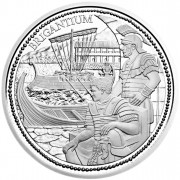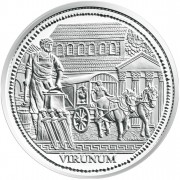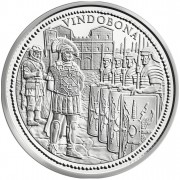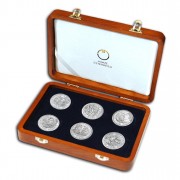- MINTS
- Australia "The Perth Mint"
- Mint of Finland
- Singapore Mint
- Mint of Austria
- Royal Dutch Mint
- Banco de Mexico
- Mint of Poland
- Mint of South Africa
- New Zealand Mint
- England "The Pobjoy Mint"
- Mint of Japan
- United States Mint
- Mint of Slovakia
- Other Mints
- Gold Coins
- Bronze Coins
- Copper Coins
- Silver Coins
- African Wildlife
- Angels
- Biblical Stories
- Christmas Coins
- Cities at Night
- Classical Painters
- Composers
- Coral Protection
- Dangerous Snakes
- Deep Sea Fish
- Disappearing Animals
- Famous Grand Operas
- Famous Pirates
- Flora & Fauna of the Pyrenees
- Great Commanders & Battles
- Greatest She Warriors
- Hanseatic League Sea Trading Route
- History of the Crusades
- Jelly Fish
- Masters of Europe
- Pilgrimage & Golden Rose
- Predator Hunters
- Prehistoric Art, Cave Paintings
- Prehistoric Wildlife
- Pyrenees Wildlife
- Rare Wildlife
- Religious People
- Sculptures of the World
- Single Issues
- Ten Commandments
- Venomous Spiders
- World of Frogs
- World of Insects
- COINS BY COUNTRY
- Andorra
- Armenia
- Australia
- Austria
- Belarus
- Benin
- British Virgin Islands
- Cameroon
- Canada
- China
- Congo
- Cook Islands
- Czech Republic
- Fiji
- Finland
- Germany
- Isle of a Man
- Ivory Coast
- Japan
- Kazakhstan
- Kiribati
- Korea North
- Korea South
- Laos
- Liberia
- Macao
- Malawi
- Mexico
- Netherland
- New Zealand
- Niger
- Niue
- Palau
- Papua - New Guinea
- Pitcairn
- Poland
- Singapure
- Somalia
- South Africa
- Togo
- Tokelau
- Tuvalu
- United Kingdom
- United States
- Vanuatu
- Coins by Weight and Metals
- Themed Coins
- Recent Releases
 Login
Login
- The Perth Mint Investment Coins
Gold Bullion Coins T here are two forms of 99.99% pure gold coins:The traditional Australian Ka... Read more >>>
- US Mint Silver Eagle Sales Jump 88% to a Record 3.2 Million on First Day of 2012
US Mint Silver Eagle Sales Jump 88% to a Record 3.2 Million on First Day of 2012 The US Mint has started 201... Read more >>>
- World's Biggest Coin- a Million Dollar value
Canada has seized bragging rights for the largest legal tender piece of money in the world, by issuing a coin with a fac... Read more >>>
Silver Coin "LAURIACUM" 2012 “Romans on the Danube” Series
| Specifications | |
| Metal | Silver |
| Fineness (% purity) | 90.0 |
| Content (Troy OZ) | 0.58 |
| Denomination (EURO) | 20 |
| Weight (g) | 18.00 |
| Diameter (mm) | 34.0 |
| Year of Issue | 2012 |
| Country | Austria |
| Edge | smooth |
| Quality | Proof |
| Mintage | 50,000 |
| Package type includes | Red Box |
| Certificate of Authenticity | YES |
Also Available
Price includes FREE presentation gift coin box and FREE same day shipping. Only First Coin Company provide this options to our dear clients!
April 11, 2012 – Vienna, The Austrian Mint today will issue the fifth silver coin in the intriguing “Rome on the Danube” series. The Roman Empire was certainly very powerful and influential in many regions of Europe; today’s Austria was no exception. Much of this was because of the Danube River, one of the key transportation links in the network of European rivers. Along the Danube the Romans established or adopted earlier settlements that thrived under Roman rule. Many of these settlements are still important hubs of transportation and economic contributors of Austria today, some 1500 years later.
The obverse of the coin was designed by the mint’s Chief Engraver, Thomas Pesendorfer and features a portrait of Christian Emperor Flaviianus. Behind him stands St. Florian, the patron saint of the Austrian firefighters, holding a flag, a millstone and a palm frond, symbol of martyrdom. The waves represent the Enns River along which the settlement was located. The obverse of the coin along the outer edge also bears the country of issue “Republik Oesterreich,” Republic of Austria, the name of the emperor “Kaiser Gratianus”, as well as the 20-euro face value. The year of issue 2012 is centered in the lower half of the design field under the name of the settlement, Lauriacum.
The reverse of the coin shows a Roman “agrimensor”, or surveyor, overseeing the construction of a bridge while taking measurements with the help of a “groma.” On the table to his right side, plans and other geometrical tools lie on a table at his side. The groma, also known as a surveyors cross, was the principal Roman surveying instrument that was used to survey straight lines and right angles. In the background are several buildings, part of the extensive military establishment that was located in Lauriacum. Mint engraver Helmut Andexlinger created and engraved this side decided to feature the river, bridge building and roads in general, since the city of Lauriacum was a key hub of transportation both along the river and the roads of this region.
Lauriacum is located at the mouth of the Enns River where it flows into the Danube River, where today’s twin cities of Lorch and Enns are located. Enns is the oldest city of Austria, and a nearby village still carries the name of Lorch, based on its Roman history. The intersection of the two rivers here has made this location very strategic since the beginning of time. The first settlement is thought to have been here about 4000 years ago during the time of the Celts. It was a key location in the “Limes” a line of defence built by the Romans that stretched from England along the Rhine River to the mouth of the Danube River. Lauricum had over 6,000 soldiers and 30,000 residents by the time Rome granted Lauricum city status.
The Emperor Flavius Gratianus was born in what is now known as Serbia in the year 359 A.D., and he died in Lyon France in 383 A.D. He was Emperor of the western region of the Roman Empire from 375
to 383. He was seen as a very fair and formal emperor but one who was not particularly interested in politics, and depended greatly on his advisors. Emperor Gratianus visited Lauriacum in 378 A.D.
The year is significant since it is commonly recognized as the year from which Anno Domini became commonly used to mark calendar years.
Florian was a Christian soldier working in the city of Lauriacum, who was forced into retirement because of his Christian beliefs. During this time some 40 Roman soldiers were imprisoned because of their Christian beliefs. Florian decide to try and help them, and he refused to renounce his Christianity to a Roman military commander during Christian purges in AD 304. The Emperors of the time, Diocletian and Maximian, had a millstone tied around Florian’s neck and then had him drowned on May 4, 304 A.D. in the Enns River at Lauriacum. It was only some short nine years after this, that Emperor Constantine I proclaimed religious tolerance. A Christian basilica was built around 370 A.D. on top of what was the Roman temple of Jupiter.
It was not until around 420 A.D. that the city of Lauriacum began to dwindle largely due to the heavy losses that the then Emperor Flavius Constatinus suffered in the west, and the loss of North Africa.
Many soldiers withdrew as public funds for their defence work along the limes disappeared.
The new silver coin has a face value of 20 euros, is struck in proof quality only and a maximum mintage of 50,000 pieces. The coins are struck in 900 fine silver and contain 18 grams of pure silver. Each coin has a diameter of 34 mm, is encapsulated and comes in box with an individually numbered certificate of authenticity.
A wooden case for the whole collection of six coins, decorated on the top with a facsimile of a Roman sestertius (Germ.: Sesterz) coin with a portrait of the Emperor Marcus Aurelius (161-180 A.D.) is also available.
Silver Coin "LAURIACUM" is a perfect gift coin for Birthday or any special occasion for a loved one!
Nice and perfect gift!
| Specifications | |
| Metal | Silver |
| Fineness (% purity) | 90.0 |
| Content (Troy OZ) | 0.58 |
| Denomination (EURO) | 20 |
| Weight (g) | 18.00 |
| Diameter (mm) | 34.0 |
| Year of Issue | 2012 |
| Country | Austria |
| Edge | smooth |
| Quality | Proof |
| Mintage | 50,000 |
| Package type includes | Red Box |
| Certificate of Authenticity | YES |
Write a review
Your Name:Your Review:
Rating: Bad Good

 Australia "The Perth Mint"
Australia "The Perth Mint" Mint of Finland
Mint of Finland Singapore Mint
Singapore Mint Mint of Austria
Mint of Austria Royal Dutch Mint
Royal Dutch Mint Banco de Mexico
Banco de Mexico Mint of Poland
Mint of Poland Mint of South Africa
Mint of South Africa New Zealand Mint
New Zealand Mint England "The Pobjoy Mint"
England "The Pobjoy Mint" Mint of Japan
Mint of Japan United States Mint
United States Mint Mint of Slovakia
Mint of Slovakia Other Mints
Other Mints Andorra
Andorra Armenia
Armenia Australia
Australia Austria
Austria Belarus
Belarus Benin
Benin British Virgin Islands
British Virgin Islands Cameroon
Cameroon Canada
Canada China
China Congo
Congo Cook Islands
Cook Islands Czech Republic
Czech Republic Fiji
Fiji Finland
Finland Germany
Germany Isle of a Man
Isle of a Man Ivory Coast
Ivory Coast Japan
Japan Kazakhstan
Kazakhstan Kiribati
Kiribati Korea North
Korea North Korea South
Korea South Laos
Laos Liberia
Liberia Macao
Macao Malawi
Malawi Mexico
Mexico Netherland
Netherland New Zealand
New Zealand Niger
Niger Niue
Niue Palau
Palau Papua - New Guinea
Papua - New Guinea Pitcairn
Pitcairn Poland
Poland Singapure
Singapure Somalia
Somalia South Africa
South Africa Togo
Togo Tokelau
Tokelau Tuvalu
Tuvalu United Kingdom
United Kingdom United States
United States Vanuatu
Vanuatu Gold Coins
Gold Coins Niobium Coins
Niobium Coins Silver Coins
Silver Coins Bronze Coins
Bronze Coins Copper Coins
Copper Coins Platinum Coins
Platinum Coins Dragon
Dragon Love coins
Love coins SCIENCE
SCIENCE Snake
Snake Historical Events
Historical Events Unusual Shapes
Unusual Shapes Famous Persons
Famous Persons World
World Traditions
Traditions Religious
Religious Sport
Sport Calendar
Calendar Cosmos
Cosmos Transport
Transport Lucky Coins
Lucky Coins Nature
Nature Art
Art Zodiac Signs
Zodiac Signs Sets
Sets Fairy Tales
Fairy Tales

















